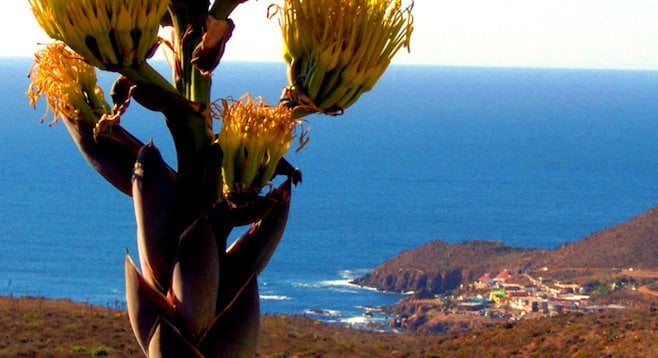 Facebook
Facebook
 X
X
 Instagram
Instagram
 TikTok
TikTok
 Youtube
Youtube

Punta Banda is a narrow, mostly barren finger of land that pokes out into the Pacific Ocean at the southern end of Bahía Todos Santos near Ensenada.
Near the very tip, busloads of bug-eyed tourists regularly stare out at the myriad of sharp, guano-covered outcroppings as they munch on crispy churros, waiting for the next influx of water to surge through the mammoth boulders at the base of the world’s second-largest blowhole, then spurt high up in the air to ultimately dissolve into a fine, cool mist that offers momentary relief under the blazing Baja sun.
Surrounded by rocky, cactus-strewn chaparral, a long row of shack-like concession stands and shops line the end of the road leading to La Bufadora. Eager vendors offer the passersby everything from the usual array of curios, plaster deities and metal sculptures to humble preparations of shellfish, candied nuts or fried seafood.
Some of the other local residents are commercial fishermen or charter skiff operators who make a good portion of their income catering to American anglers and scuba divers, who come to this special hideaway to take advantage of abundant marine life that still exists in the waters surrounding the rugged peninsula and its many hidden coves.
Standing on a hill above this modest village today, it’s apparent that the well-traveled, twisting line of somewhat-neglected asphalt that feeds La Bufadora’s tourist industry has done little to affect the stunning primitive beauty of the surrounding volcanic landscape.
Over the past few decades a surprisingly large number of ex-pats have also found a home here, many of which are fiercely independent nonconformists – refugees from the eternal battle between those who like to be told what to do, and those who don't. Nonetheless, most people who visit this region, even on a day trip, will acknowledge its special, elemental magnetism.
For those coming to Ensenada by land, La Bufadora is only about a 45-minute drive south of town on the well-marked highway. Cruise ship passengers will find a variety of transportation options to visit the blowhole as soon as they step off the gangway and onto the malecón.
It’s hard to believe that Southern California’s stressful urban overcrowding and the seemingly endless gridlock on San Diego freeways lies barely over a hundred miles north of this magical hideaway. But that is, indeed, an eternity away from here.
Up on the hill above La Bufadora, the breeze blows freely through your hair. This is a place where pelicans and seagulls dive into the ocean for their breakfast, and all the creatures of the sea and land are filled with a wild lusting for life. And while it is a life that is often stark and cruel, it is one devoid of the typical entanglements related to the societies of mankind.
It remains a more primitive but, somehow, more credible world.


Punta Banda is a narrow, mostly barren finger of land that pokes out into the Pacific Ocean at the southern end of Bahía Todos Santos near Ensenada.
Near the very tip, busloads of bug-eyed tourists regularly stare out at the myriad of sharp, guano-covered outcroppings as they munch on crispy churros, waiting for the next influx of water to surge through the mammoth boulders at the base of the world’s second-largest blowhole, then spurt high up in the air to ultimately dissolve into a fine, cool mist that offers momentary relief under the blazing Baja sun.
Surrounded by rocky, cactus-strewn chaparral, a long row of shack-like concession stands and shops line the end of the road leading to La Bufadora. Eager vendors offer the passersby everything from the usual array of curios, plaster deities and metal sculptures to humble preparations of shellfish, candied nuts or fried seafood.
Some of the other local residents are commercial fishermen or charter skiff operators who make a good portion of their income catering to American anglers and scuba divers, who come to this special hideaway to take advantage of abundant marine life that still exists in the waters surrounding the rugged peninsula and its many hidden coves.
Standing on a hill above this modest village today, it’s apparent that the well-traveled, twisting line of somewhat-neglected asphalt that feeds La Bufadora’s tourist industry has done little to affect the stunning primitive beauty of the surrounding volcanic landscape.
Over the past few decades a surprisingly large number of ex-pats have also found a home here, many of which are fiercely independent nonconformists – refugees from the eternal battle between those who like to be told what to do, and those who don't. Nonetheless, most people who visit this region, even on a day trip, will acknowledge its special, elemental magnetism.
For those coming to Ensenada by land, La Bufadora is only about a 45-minute drive south of town on the well-marked highway. Cruise ship passengers will find a variety of transportation options to visit the blowhole as soon as they step off the gangway and onto the malecón.
It’s hard to believe that Southern California’s stressful urban overcrowding and the seemingly endless gridlock on San Diego freeways lies barely over a hundred miles north of this magical hideaway. But that is, indeed, an eternity away from here.
Up on the hill above La Bufadora, the breeze blows freely through your hair. This is a place where pelicans and seagulls dive into the ocean for their breakfast, and all the creatures of the sea and land are filled with a wild lusting for life. And while it is a life that is often stark and cruel, it is one devoid of the typical entanglements related to the societies of mankind.
It remains a more primitive but, somehow, more credible world.
Comments